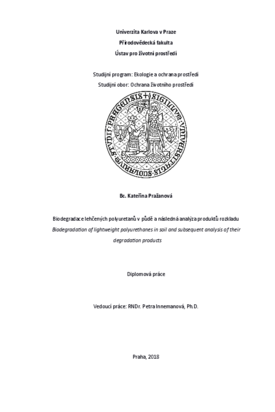Biodegradace lehčených polyuretanů v půdě a následná analýza produktů rozkladu
Biodegradation of lightweight polyurethanes in soil and subsequent analysis of their degradation products
diplomová práce (OBHÁJENO)

Zobrazit/
Trvalý odkaz
http://hdl.handle.net/20.500.11956/102155Identifikátory
SIS: 182647
Kolekce
- Kvalifikační práce [21483]
Autor
Vedoucí práce
Oponent práce
Cajthaml, Tomáš
Fakulta / součást
Přírodovědecká fakulta
Obor
Ochrana životního prostředí
Katedra / ústav / klinika
Ústav pro životní prostředí
Datum obhajoby
7. 9. 2018
Nakladatel
Univerzita Karlova, Přírodovědecká fakultaJazyk
Čeština
Známka
Výborně
Klíčová slova (česky)
biodegradace, lehčené polyuretany, produkty rozkladu, mikroplasty, adsorpce polycyklických aromatických uhlovodíkůKlíčová slova (anglicky)
biodegradation, lightweight polyurethanes, degradation products, microplastics, adsorption of polycyclic aromatic hydrocarbonsPředcházení vzniku odpadů je podle evropské směrnice Evropského Parlamentu a Rady 2008/98/ES o odpadech a podle zákona o odpadech č. 185/2001 Sb., ve znění pozdějších předpisů, hlavní prioritou v nakládání s odpady. Využit biodegradovatelných plastů se jeví jako vhodný přístup v naplňování této strategie. Předložená diplomová práce se zabývá biodegradovatelnými lehčenými polyuretany (PUR), které mohou představovat vhodné materiály pro využit na pachové ohradníky v zemědělské krajině, kde je v půdě předpokládán jejich rozklad po skončení životnost. Biodegradovatelnost nově syntetzovaných lehčených PUR (BIO 8-10), vyjádřená jako mineralizace materiálu, byla laboratorně testována v zemědělské půdě podle standardizované metody ASTM D5988-03. Během devítměsíčního pokusu byl nejlépe rozložitelný materiál (BIO-10) obsahující škrob (28 hm. %) rozložen z 42,0 ± 4,2 %. Pozitvní kontrola tvořená celulózou byla kompletně rozložena, čímž test naplňoval kritérium validity, které požaduje mineralizaci > 70 %. Po biodegradačním testu byly produkty rozkladu (rezidua PUR) z půdy separovány dvoustupňovou metodou využívající fuidizace a fotace podle upraveného postupu Nuelle et al. (2014). Zvládnut tohoto postupu umožňovalo následnou analýzu reziduí pomocí infračervené spektroskopie s Fourierovou transformací (FT-IR)....
According to the Waste Framework Directie 2008/98/ES and the Czech law on waste 185/2001 Sb., waste preienton is the main priority in waste management. Using biodegradable plastcs seems to represent a suitable approach in fulflling the strategy. The subject of this diploma thesis is biodegradable lightweight polyurethanes (PURs), which might represent suitable materials for repellent fences in agricultural landscapes. Biodegradaton processes are assumed to begin in the agricultural soil afer their lifetme. The biodegradability of new lightweight PURs (BIO 8-10), presented as material mineralizaton, was tested in agricultural soil under laboratory conditons according to the ASTM Internatonal standard method D5988-03. Afer the nine-month experiment the material with the highest biodegradability (BIO 10) containing starch (28 wt. %) was mineralized to 42.0 ± 4.2 %. Cellulose (the positie control) was completely mineralized; thus, the ialidity criterion (positie control mineralizaton > 70 %) was accomplished. Afer the biodegradability test, degradaton products (residual PURs) were separated from the soil by a two-step method using fuidisaton and fotaton, according to a modifed procedure described in Nuelle et al. (2014). The procedure enabled a subsequent analysis of PUR residues with Fourier transform...
